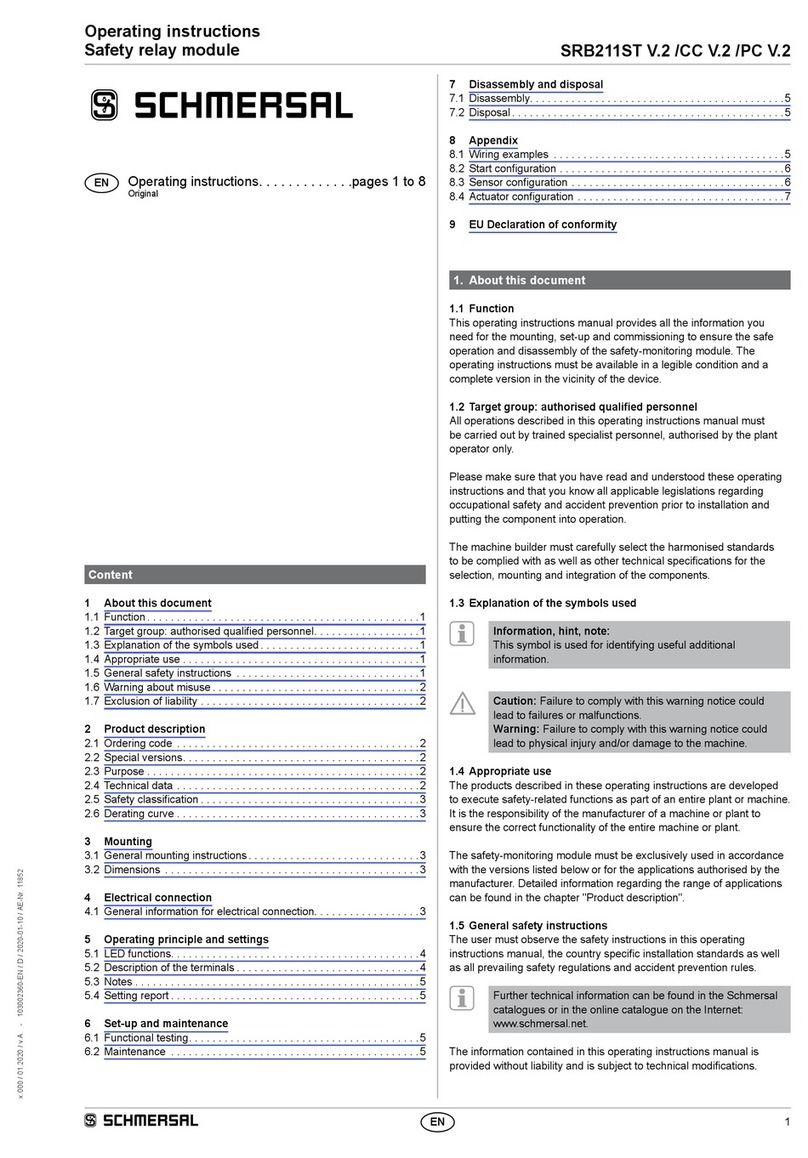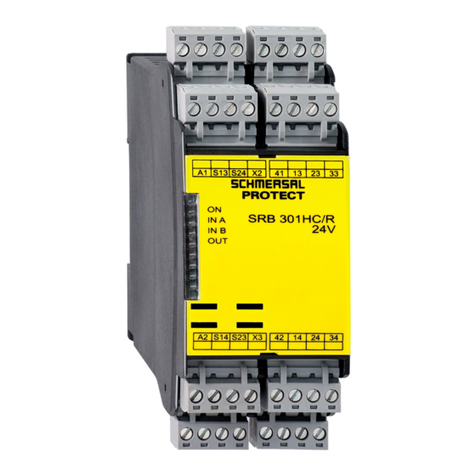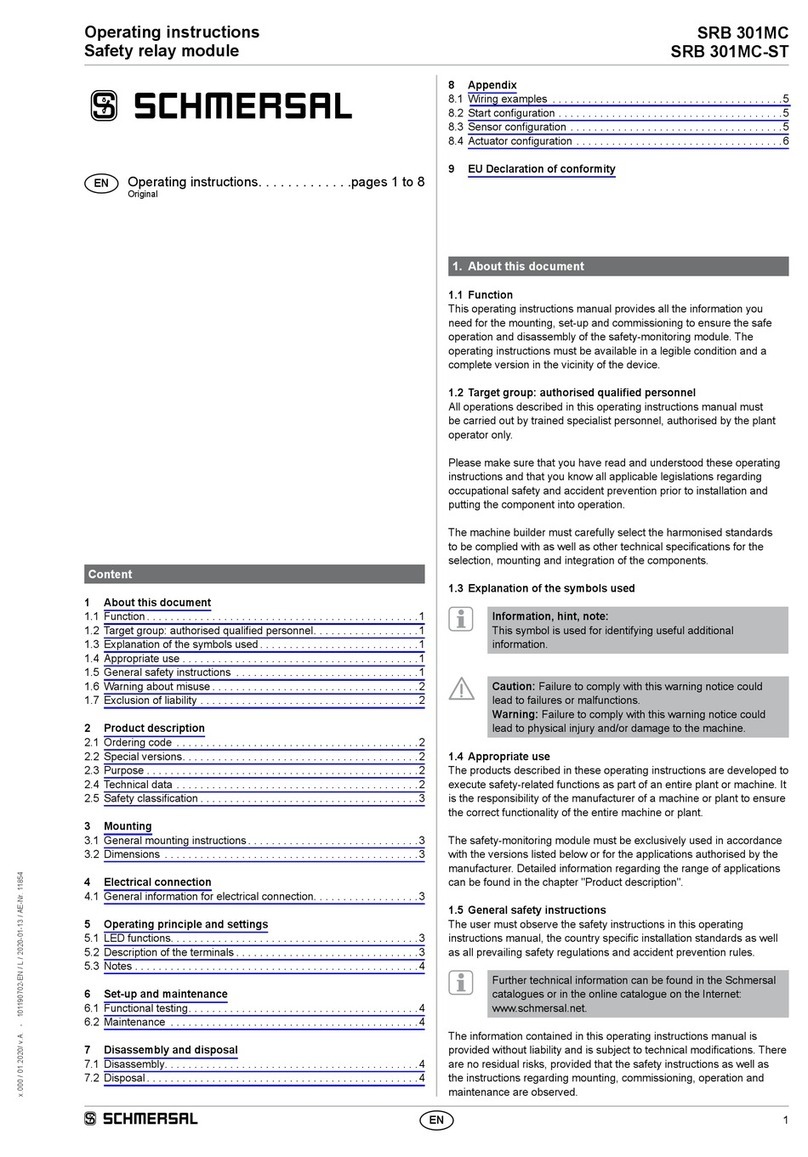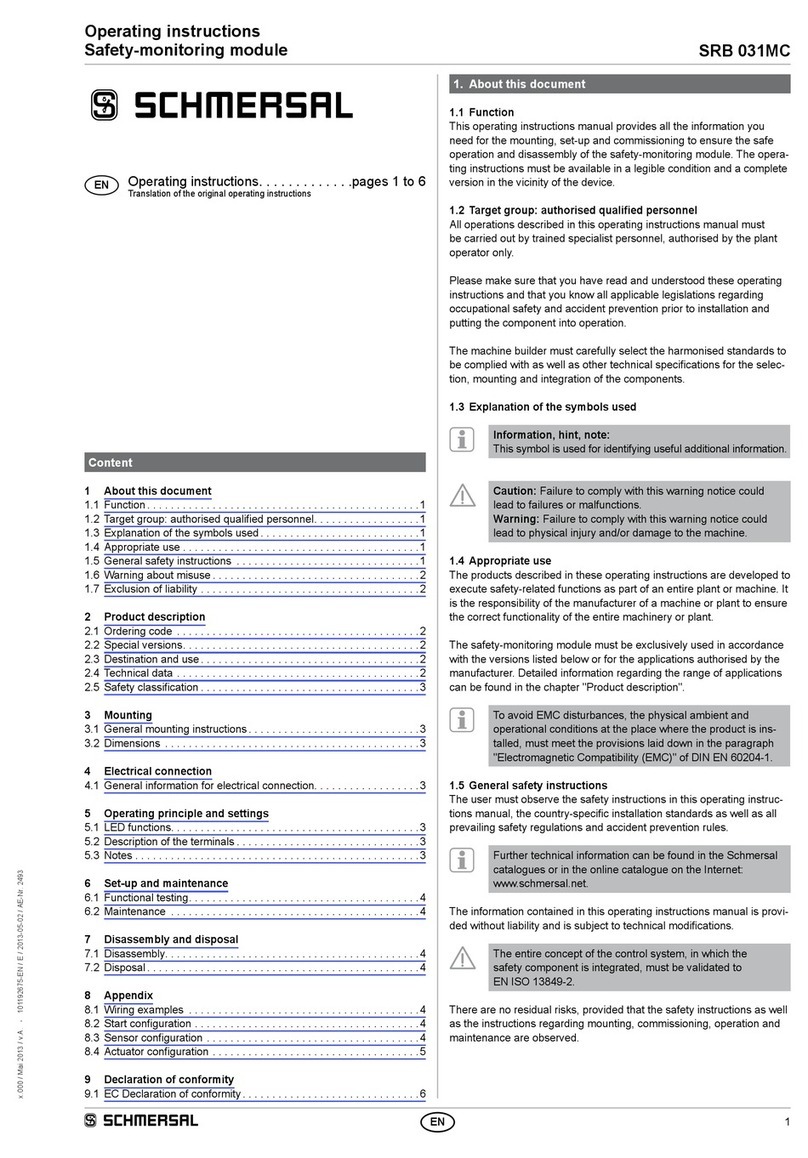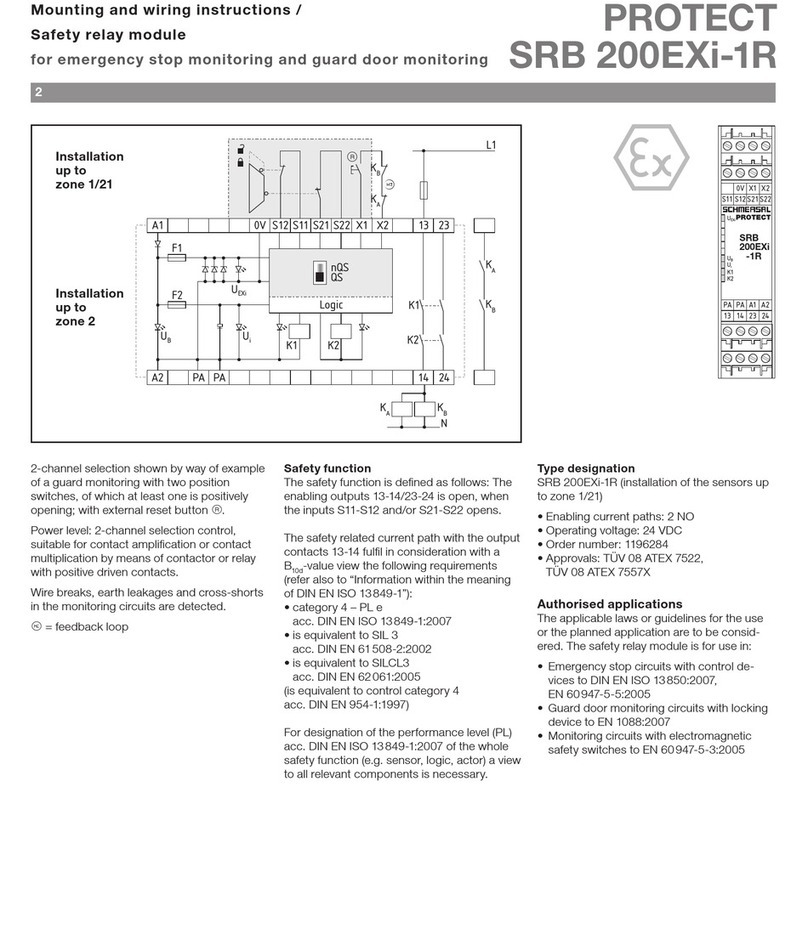
2
Operating instructions
Safety relay module
SRB 400C…
SRB 400SNA
EN
1.6 Warning about misuse
In case of inadequate or improper use or manipulations of
the safety-monitoring module, personal hazards or damage
to machinery or plant components cannot be excluded.
The relevant requirements of the standards ISO 14419 and
ISO 13850 must be observed.
1.7 Exclusion of liability
We shall accept no liability for damages and malfunctions resulting from
defective mounting or failure to comply with this operating instructions
manual. The manufacturer shall accept no liability for damages
resulting from the use of unauthorised spare parts or accessories.
For safety reasons, invasive work on the device as well as arbitrary
repairs, conversions and modifications to the device are strictly
forbidden, the manufacturer shall accept no liability for damages
resulting from such invasive work, arbitrary repairs, conversions and/or
modifications to the device.
The safety-monitoring module must only be used when the enclosure is
closed, i.e. with the front cover fitted.
2. Product description
2.1 Ordering code
This operating instructions manual applies to the following types:
SRB 400
➀
No. Option Description
➀
CS Reset not monitored, optional automatic reset*
(pull-in delay, see technical data)
SNA Reset not monitored, optional automatic reset*
(pull-in delay, see technical data)
CS/T Reset monitored*
CA Reset not monitored, optional automatic reset*,
switch-off level 2 with antivalent inputs
CA/T Reset monitored*, switch-off level 2 with antiva-
lent inputs, cross-wire short detection*
CA/Q Reset not monitored, optional automatic reset*,
switch-off level 2 with antivalent inputs
CA/QT Reset monitored*, switch-off level 2 with antiva-
lent inputs, cross-wire short detection*
* with reference to switch-off level 1
Only if the information described in this operating instructions
manual are realised correctly, the safety function and
therefore the compliance with the Machinery Directive is
maintained.
2.2 Special versions
For special versions, which are not listed in the order code below 2.1,
these specifications apply accordingly, provided that they correspond to
the standard version.
2.3 Purpose
The safety-monitoring modules for integration in safety circuits are
designed for fitting in control cabinets. They are used for the safe
evaluation of the signals of positive break position switches or magnetic
safety sensors for safety functions on sliding, hinged and removable
safety guards as well as emergency stop control devices and AOPD's.
The safety function is defined as the opening of the enabling circuits
13-24 and 33-44 when the inputs S31-S32 and/or S41-S42 (S43-S44)
are opened and as the opening of the enabling circuits 13-14, 13-24,
33-34 and 33-44 when the inputs S12 and/or S22 are opened. The
safety-relevant current paths with the output contacts 13-14, 13-24,
33-34 and 33-44 fulfil the following requirements in consideration of a
B10D value (see also "Details in terms of ISO 13849-1“):
– Category 4 – PL e in accordance with ISO 13849-1
– Complies with SIL 3 in accordance with IEC 61508-2
– Complies with SILCL 3 in accordance with EN 62061
To determine the Performance Level (PL) to ISO 13849-1 of the entire
safety function (e.g. sensor, logic, actuator), an assessment of all
relevant components is required.
The entire concept of the control system in which the safety
component is integrated, must be validated to the relevant
standards.
2.4 Technical data
General data
Standards: EN 60204-1, IEC 60947-5-1,
ISO 13849-1, IEC 61508
Climate resistance: EN 60068-2-78
Mounting: snaps onto standard rail to EN 60715
Terminal designations: IEC 60947-1
Material of the housings: Plastic, glass-fibre reinforced
thermoplastic, ventilated
Material of the contacts: AgNi, self-cleaning, positive drive
Weight: 235 g
Start conditions: Automatic or start button
(Refer to 2.1 Ordering code)
Feedback circuit (Y/N): yes
Pull-in delay with reset button: Switch-off level 1: typ. 40 ms
Switch-off level 2: typ. 350 ms
Switch-off level 2 typ. SNA: 80 ms
Drop-out delay in case of emergency stop: typ. 50 ms
Mechanical data
Connection type: Screw connection
Cable section: min. 0,25 mm² / max. 2,5 mm²
Connecting cable: rigid or flexible
Tightening torque for the terminals: 0.6 Nm
With removable terminals (Y/N): yes
Mechanical life: 10 million operations
Electrical life: Derating curve available on request
Resistance to shock: 10 g / 11 ms
Resistance to vibration in accordance
with EN 60068-2-6: 10 ... 55 Hz,
amplitude 0.35 mm
Ambient conditions
Ambient temperature: –25 °C … +45 °C
Storage and transport temperature: –40 °C … +85 °C
Protection class: Enclosure: IP40
Terminals: IP20
Clearance: IP54
Air clearances and creepage distances to IEC 60664-1: 4 kV/2
(basic insulation)
EMC rating: to EMC Directive
Electrical data
Contact resistance in new state: max. 100 mΩ
Power consumption: max. 4.4 W
Rated operating voltage Ue:24 VDC –15% / +20%,
residual ripple max. 10%
Fuse rating for the operating voltage: electronic fuse,
Tripping current > 1 A;
Reset after approx. 1 sec.
Monitored inputs
Short-circuit recognition (Y/N): Refer to 2.1 Ordering code
Wire breakage detection (Y/N): Yes
Earth leakage detection (Y/N): Yes
